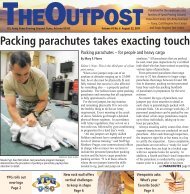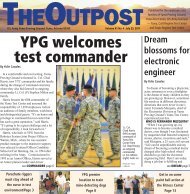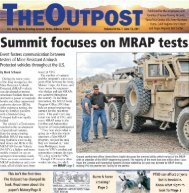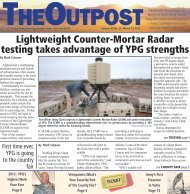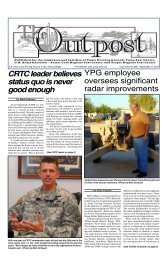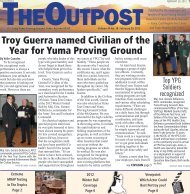YPG's new Candlewood Suites a 'dream-come-true'
YPG's new Candlewood Suites a 'dream-come-true'
YPG's new Candlewood Suites a 'dream-come-true'
You also want an ePaper? Increase the reach of your titles
YUMPU automatically turns print PDFs into web optimized ePapers that Google loves.
6 SEPTEMBER 3, 2012 THE OUTPOSTT<br />
Block III Apache gun tests<br />
By Mark Schauer<br />
A primary responsibility of<br />
Yuma Proving Ground is to support<br />
developmental testing designed<br />
to asses improvements to existing<br />
weapons systems, even on platforms<br />
considered the most lethal of their<br />
kind, such as the AH-64D Apache<br />
Longbow attack helicopter. Having<br />
been involved in Apache<br />
testing for over 30 years,<br />
the Air Combat Systems Test<br />
Directorate boasts<br />
a huge amount<br />
of institutional<br />
knowledge and<br />
experience.<br />
This knowledge<br />
has been brought<br />
to bear across<br />
the extensive<br />
Apache<br />
Block III<br />
improvements<br />
to the long-serving<br />
airframe that have<br />
been taking place at the proving<br />
ground since 2009. The latest version<br />
of the Apache boasts a wide array<br />
of upgrades, from a <strong>new</strong> engine and<br />
transmission to instrumented flight<br />
capability normally associated with<br />
large airplanes. More excitingly,<br />
the gunner aboard<br />
nearly complete<br />
Proven to be a robust aircraft with a remarkable ability<br />
the updated Apache is able to control<br />
an armed, fully functional unmanned<br />
aerial system (UAS) from the cockpit.<br />
Survivability is a critical<br />
component of any attack helicopter,<br />
and the Apache has been designed<br />
as a heavily-armored fortress. It<br />
has proven to be a robust aircraft<br />
with a remarkable ability to return<br />
to friendly territory and land safely<br />
even when severely damaged by<br />
enemy fire. Yet the Apache<br />
is no lumbering<br />
behemoth: its primary defensive<br />
strategies are stealth and evasion,<br />
and the aircraft is particularly adept<br />
at low-altitude flying as a means<br />
of escaping radar detection. It has<br />
always been identified with state-ofthe-art<br />
sensors and precision<br />
guidance systems, as well as lethal<br />
air-to-surface missiles.<br />
The aircraft’s M230 30 millimeter<br />
chain gun in a turret below the<br />
cockpit is another deadly part of its<br />
arsenal, capable of firing hundreds<br />
of rounds per minute. As the aircraft<br />
reacts to the powerful gun’s recoil<br />
during firing, however, the gun’s<br />
pointing angle moves. Without<br />
sophisticated software that corrects<br />
the aim<br />
point<br />
of the gun, the<br />
rounds would be<br />
thrown off target as<br />
the aircraft<br />
bends. To<br />
prevent<br />
this,<br />
YPG testers<br />
have recently<br />
conducted over 25<br />
test flights in which<br />
the fire control and<br />
targeting systems were<br />
put through their paces<br />
against a variety of<br />
stationary targets from<br />
multiple angles that<br />
[Top] Having tested variants of the Apache attack helicopter for over 30 years, YPG was the ideal location to test<br />
the extensive improvements on the latest iteration, the Block III. “This is the greatest place in the world for our<br />
purposes,” said Dan Girardin, Boeing Flight Test Engineer. [Right] The Apache’s M230 30 millimeter chain gun is<br />
capable of firing hundreds of rounds per minute, and requires sophisticated software that corrects the aim point of the gun when the aircraft<br />
is firing while flying. Here, support personnel prepare to reload the gun during a long day of test firing. PHOTOS BY MARK SCHAUER<br />
simulate actual combat conditions.<br />
“The purpose of this subtest is to<br />
take a random sampling of multiple<br />
aircraft and characterize the shift<br />
of individual turret and air frames<br />
fired at various angles,” said Pat<br />
Franklin, test officer. “Each airframe<br />
has a slightly different variation,<br />
and characterizing these differences<br />
allows designers to find a best-fit<br />
software for the entire fleet.”<br />
To accomplish this type of testing,<br />
YPG evaluators use a massive target<br />
70 feet tall and 30 feet wide and<br />
covered with thick armor plating.<br />
The chain gun’s 30 millimeter<br />
b<br />
c



